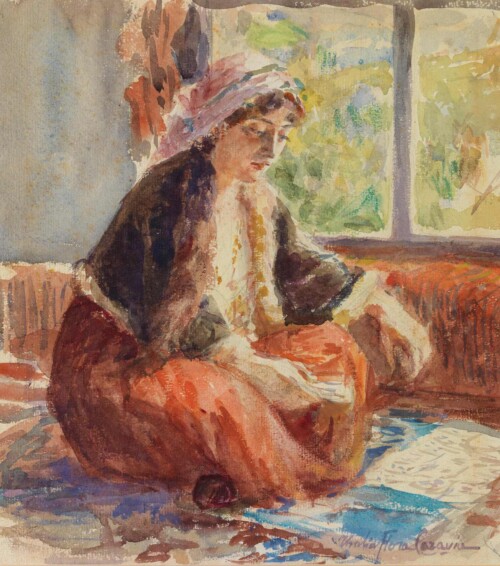| 14 |
Greek, 1871-1960
Greek peasant woman by the window
watercolour on paper
signed lower right
28.7 x 25.5 cm
PROVENANCE
private collection, Athens
| sold for 1,767.75 € |
Thalia Flora-Caravia studied at the Zappio School for girls in Constantinople and graduated in 1888.
At the time women were not allowed to study at the School of Fine Arts, Athens, so Flora-Caravia moved to Munich and for three years studied with the notable Greek artists Nikolaos Gyzis and Georgios Jakobides. She simultaneously attended classes in drawing and colour with Paul Nauen, Anton Azbe and Walter Thor.
In 1898 she returned to Constantinople where she began her career in painting. Later, in 1907, she married N. Caravias, publicist of the newspaper Εφημερις, and settled down in Alexandria, Egypt, where she lived for the next 30 years. In Alexandria, as well as continuing her artistic career, Flora-Caravia established an art school that proved to have significant influence in the area.
Her work is influenced by the Munich school, fauvism and by post-impressionism, and is characterised by simplicity, sincerity in execution, vivid colour and a powerful brush stroke. Her subject matter included portraiture, landscape, seascape and scenes of everyday life.
During the Balkan wars of 1912-1913, she followed the Greek army as a correspondent for the Alexandrian newspaper headed by her husband. She recorded the everyday lives of the troops, refugees and casualties, later to be published in the book ‘Impressions of the 1912-1913 war in Macedonia and Epirus’. She also recorded the Asia Minor campaign of 1919-1922 and the Albanian front during the Greek-Italian war of 1940-1941. Many of these works are exhibited at the War Museum in Athens.
Flora-Caravia travelled extensively and exhibited her work in Greece, Asia Minor, Europe and the USA. In 1940 she moved to Athens where she lived for the remainder of her life.
Her work can be found in many public and private collections, notably: The National Gallery of Greece, the Athens Municipal Gallery, the Leventis Gallery, the Koutlides Collection, the Averoff Gallery, the National Bank of Greece, and so on.
